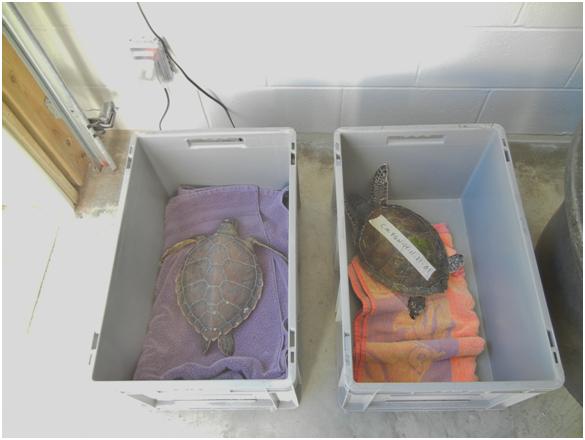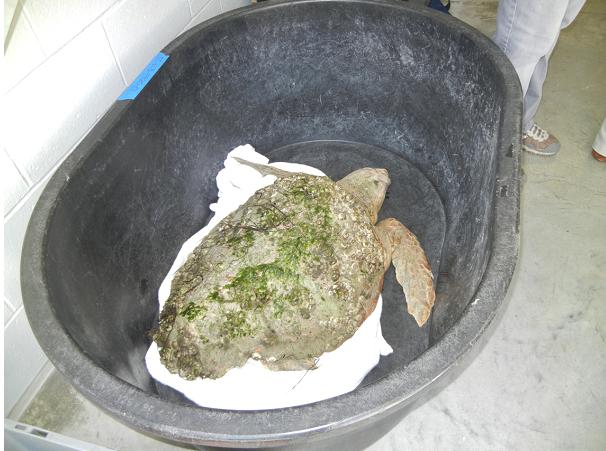Cold Stun Season Has Begun…a little early…but now we have the STAR Center and we are ready! It was a 48 degree, blustery day on November 21 when the call came out from the hotline about a turtle being found.
9:45 AM A Hatteras Island N.E.S.T. responder receives a call about a turtle found in distress and contacts the N.E.S.T. hotline to request transport to the STAR Center and begins his 20 mile ride north from Buxton to Rodanthe, where the turtle was found floating behind a fisherman’s cottage.
9:50 AM The broadcast call goes out from the N.E.S.T. hotline to over 30 stranding volunteers seeking a driver.
10:05 AM A volunteer responds and gets instructions on the pick-up location….Liberty Gas Station in Rodanthe. With a transport container in the back, the heat turned off to keep the car cool, and a NC Wildlife Resources Commission permit around the neck, the driver sets off on the 38 mile run south from Kill Devil Hills. The driver travels through Cape Hatteras National Seashore, past the Bodie Island lighthouse, and over the Bonner Bridge to Hatteras Island and through Pea Island National Wildlife Refuge. The ponds of the refuge are covered with tundra swans and snow geese who find our winter temperatures to be quite pleasant. The turtles in Pamlico Sound are warm water creatures. They shouldbe moving south about now.
10:45 AM The N.E.S.T. volunteers meet Behold, there is another turtle! The National Park biologist has found a little green. for the transfer at the gas station. The two first responders fill out stranding reports, providing information about where and in what condition the turtles were found. Each is assigned a unique number for the treatment records. Today’s turtles are CM FGW 14112101 and CM WPT 14112102.
11:05 AM The two turtles are transferred for delivery to the Sea Turtle Assistance and Recovery (STAR) Center. The driver calls in an approximate arrival time and off they go. Because sea turtles are cold-blooded animals, they assume the temperature of their surroundings: they’re hot when their environment is hot and cold when their environment is cold. When sea turtles are exposed to frigid water temperatures (about 50 degrees F) over a period of several days, their circulatory systems can slow to the point that they become cold-stunned and unable to swim or function properly. (from NOAA)
The waters of the Pamlico Sound off Hatteras Island are very shallow (6-12 feet) and chill very quickly when the air temperature suddenly drops and even more quickly if there is any wind. The smaller turtles like to feed in the sound because it is so shallow and get caught by surprise by the sudden change. Paralyzed and unable to swim, they drift with the tides; the lucky ones wash up near shore or float around boat docks where they may be found in time before their organs shut down completely.
Once they are found, the turtles’ bodily systems need to be restarted slowly. Ideally, they should be exposed to gradually rising temperatures. And no loud music, because that would be a foreign and possibly frightening sound.
So on with the journey…
11:10 AM Back through the refuge, over the Bonner bridge, where flocks of birds fly overhead, and past the lighthouse. Arriving at Whalebone Junction, the driver and turtles head West to Roanoke Island, home of the NC Aquarium on Roanoke Island and the STAR Center.
11:45AM Aquarium staff and N.E.S.T. volunteers unload the new occupants of the STAR Center. Placed in separate bins in the unheated treatment room, the greens join a loggerhead that came in the day before. In a few days, they hopefully will join the other occupants in one of the 77 degree water tanks.


Transfer completed, we all cross our fingers and hope the turtles were found in time! And the Hatteras Island volunteer heads back out to search for some more cold stuns. The weather forecast is for more of the same. So, unfortunately, his odds are good. [The next day 7 more turtles were found.]
